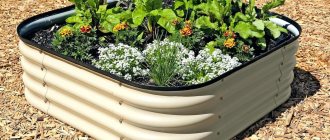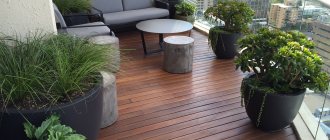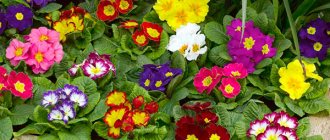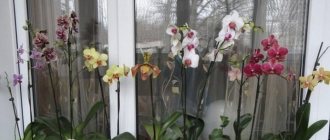When choosing flowers for your site, you should take into account their flowering period, otherwise not all flower beds will turn out beautiful. If you want to simplify the task, give preference to long-flowering plants that will look bright and aesthetically pleasing all summer.
Perennial flowers are an excellent option for summer residents who do not have time to bother with seedlings. These plants will bloom just as richly as annuals and will save you money. After all, it is enough to purchase planting material once, and then the plants can be propagated by seeds, cuttings or rhizomes. As for care, without a doubt, perennials require attention, but not all of them are so capricious. Among the large assortment of plants, there are also not very whimsical specimens. We recommend that you pay attention to perennials, which, in addition to the advantages described above, have one more thing: they bloom at least from June to August.
There are a few things to consider before planting perennials. Firstly, do not expect lush flowering immediately in the first year after planting. Many plants first need to grow, and only after a year or even a couple of years will they show themselves in all their glory. But the wait is definitely worth it! Secondly, when purchasing, pay attention to the type of plant and its flowering period. It can differ significantly among different varieties of the same species.
- 30 ideas: how to design a flowerbed of perennials that will bloom all summer
Compositions of perennials can decorate the garden for the entire season; the main thing is to find the necessary harmony between the plants.
Now let’s get acquainted with the brightest and most unusual perennials that will decorate your site all summer.
Astilbe - a moisture-loving beauty
Lush astilbe bushes look beautiful even after flowering, which usually lasts from early June to early August. The plant will like it best in a semi-shade flower garden or near a pond, because... Astilbe loves well-moistened fertile soil. Young bushes grow quickly and over time can grow up to 2 m in height (depending on the variety).
- Astilbe - planting and care in open ground
Secrets of growing astilbe in a summer cottage.
Early perennial primroses
Before purchasing the earliest perennials, it is important to know the planting rules. The work is not difficult, even a novice gardener can handle it:
- Imagine what the new flower garden will look like.
- Know what type and growth the selected variety is. Low-growing plants are planted in the foreground, tall plants are placed in the background.
- Border flowers are placed only along paths and paths.
- When planting, it is important to consider the color scheme, flowering time and care rules.
Snowdrop
The early perennial got its name from its appearance immediately after the snow melted. The flowers are early, becoming active in early March. The plant is bulbous and looks great near trees and shrubs.
When planting in a flowerbed, you need to remember that the species has a short flowering period. Snowdrops are ephemeroids, so their growing season is short. After flowering it withers and dies.
Important! Snowdrops grow quickly, so in the spring, after flowering has ended, the bulbs are dug up, divided and left until planting in the fall.
Snow-white flowers from under the snow are a symbol of the coming spring
Muscari (Mouse Hyacinth)
Muscari (mouse hyacinth) is a beautiful, early perennial. The plant is unpretentious, grows quickly, forming a beautifully blooming spring carpet. To make it happy in April, the bulbs are planted in the fall.
Mouse hyacinths look great near borders, in single groups, or in flower beds in combination with other primroses. Muscari are propagated by children, therefore, to make work easier during transplantation, the plant is planted in baskets made independently. You can build them from plastic bottles, making holes in them for drainage.
Muscari has a second name - mouse hyacinth
Crocus
An early perennial that begins to bloom in late February. When choosing a variety, it is better to give preference to crocuses such as:
- Tommasini;
- Golden-flowered;
- Imperata;
- Ankirsky.
The perennial can grow anywhere. It is planted in flower beds, under trees and shrubs, along paths and on the lawn. It can also be grown at home, as it thrives both in open ground and in flower containers.
Read more Low-growing perennial flowers that bloom all summer
Crocuses are planted in the fall. To do this, choose a sunny place or light partial shade. The early perennial is unpretentious and tolerates severe frosts well. Propagated by bulbs as needed.
Important! Since rodents love to feast on bulbs, planting is done in specially designed baskets.
Crocuses look beautiful outdoors
Iridodictium
Iridodictium are bulbous flowers that look like iris. The perennial is small, reaches a height of about 10 cm. Despite their small size, it is impossible to pass by the flowers, as they are attractive and elegant. To obtain early flowering, the bulbs are planted in the fall in a well-lit place.
The early perennial will look great near trees, next to other bulbous representatives, on lawns and as single specimens. Iridodictium is an ephemeroid; after flowering it withers and dies.
Experienced gardeners recommend digging up the bulbs after flowering. Planting material is stored in a dry place, protected from sunlight.
Beautiful flowers appear in early spring
Daffodils
Narcissus is a perennial, unpretentious bulbous plant. Depending on climatic conditions, flowering occurs from March to May. The flower can reach from 10 cm to 60 cm. The color and structure of the flower can be very diverse.
The perennial is unpretentious and winter-hardy. Prefers to grow in sunny or light partial shade, on fertile, well-drained soil. Flowers look beautiful in numerous groups, near trees and shrubs, in combination with other perennials.
Terry varieties look beautiful in a bouquet
Tulips
An early perennial, bulbous plant that includes a large number of species and varieties. The plant can reach from 15 to 70 cm. The flower consists of 6 petals with single, mixed or two-color pigmentation.
The early perennial prefers a sunny place with fertile, moisture-permeable soil. They look great among bulbous plants, in flowerpots, as a separate specimen surrounded by other varieties and species.
Important! The plant is frost-resistant; the bulbs are not dug up for the winter.
Tulips are distinguished by their unpretentiousness and variety of shades
Vesennik
An early flowering perennial, the first flowers appear in late March or early April. The plant is frost-resistant and tolerates spring frosts well. Vesennik forms a small bush, no more than 10 cm high. Inflorescences with a diameter of 2.5 cm are painted in a bright lemon color. Most often it is grown with other primroses; they look great with snowdrops and crocuses.
Read more Perennials for the Leningrad region: photos and names
Vesennik can grow in any soil, as long as it is not too wet or too dry. Since in its natural environment the plant lives in the forest, it can be planted around trees and shrubs.
Flowering occurs in March or early April
Scilla
Scilla is an early perennial that blooms at the end of March. The plant is small, has sky-blue or snow-white bell-shaped flowers. Scilla is unpretentious and can grow in the sun and shade, on well-moistened soil.
Reproduction occurs by daughter bulbs and seeds. The flower grows quickly, so to prevent it from taking over the entire garden, frequent thinning is required. Scilla goes well with snowdrops and crocuses.
In spring, heavenly bell flowers appear on the plant
Sanguinaria canadensis
Cold-resistant, early perennial. The plant is small and blooms in early spring, immediately after the snow melts. Flowering is short-lived, lasting 2-3 weeks. Inflorescences with a diameter of 5 cm can be simple or double. Elongated petals of snow-white color, lemon core.
Singuinaria canadensis grows in any light, but abundant flowering will only occur in sunny places.
Propagated by dividing the bush, does not need shelter for the winter
Anemone (Anemone)
Anemone or Anemone is an early perennial plant with a fleshy rhizome or tuber. Depending on the variety, it reaches from 10 to 150 cm. Flowers are single or collected in small groups. The color of the petals can be white, pink, sky, red. The shapes are simple and terry.
Depending on the variety, it grows in shade, partial shade, or sun. In landscape design they are used to create bright compositions and bouquets. Due to poor seed germination, anemone is propagated by dividing the bush.
Important! Anemone is a poisonous plant.
Anemone blooms immediately after the snow melts
Brunner
An early perennial with miniature sky-blue flowers. The herbaceous plant forms a bush up to half a meter high. Large heart-shaped leaves are colored a rich olive shade. Miniature flowers are collected in paniculate inflorescences. Activity is early, the first flower stalks appear in mid-April and last about 4 weeks.
Important! Brunnera is not afraid of harsh winters and can grow for 15 years without replanting.
If you follow the rules of care, the flower can bloom again in the fall.
Blood red geranium is an enemy of pests and weeds
farmyardnurseries.co.uk
The long-flowering geranium of this species gets its name because its foliage turns bright red in the fall. No less beautiful are the flowers that appear on the bushes throughout the summer. An overgrown spherical geranium bush up to 60 cm high feels great in partial shade on neutral soil. It can grow in one place for at least 10 years.
Garden geranium repels pests, prevents the growth of weeds and attracts pollinating insects, so you can plant it close to the beds.
- What is the difference between geranium and pelargonium or are they different names for the same plant?
To properly care for a plant, you need to know what it is called. Let's figure it out together!
Primrose
Primrose - a universal solution for home and garden Source www.ve.lt
An ornamental plant, such as primrose, reaches a height of 10 to 50 cm. It has a wide variety of colors and bud shapes, you can choose it to suit every taste. Given the right care conditions, these beautiful plants will reproduce each year, adding new color to your landscape. Flowering often lasts throughout the summer, and in some areas continues throughout the autumn season and provides long-lasting blooms. Growing primroses is easy, as these plants are quite hardy and easily adapt to environmental factors. You need to buy primroses for seedlings that are healthy, strong and with unopened buds.
Water the flowers thoroughly after planting. Add a layer of mulch around plants to retain moisture. Continue to water primroses throughout the summer months, about once a week or more during dry periods, but reduce the amount of watering as fall approaches.
Autumn colors Source www.pinterest.com
If primrose plants do not receive adequate drainage, they may also be susceptible to crown rot and root rot. This can be easily corrected by amending the soil with compost or moving the plants to a well-drained area. Too much moisture can also make the primrose flower susceptible to fungal infections. This can often be prevented by watering well and spacing plants sufficiently when planting.
They love the sunny side, shade and partial shade. Flowering - from October to April or from February to September.
Once they finish blooming, you will need to water them less often. Primrose usually does not survive winter.
Perennial carnation - blooms and smells
Perennial carnation has a pleasant spicy aroma and blooms profusely from June to September. The plant does not require complex care, it is not afraid of cold and drought, the only thing is that it should not be over-watered. Choose a sunny place for planting, with slight shading in the afternoon. Carnation prefers light soils, with a predominance of peat.
Read our article about what varieties of perennial carnations you can plant on your site.
- What types of carnations are there - photos, descriptions of types, popular varieties
Types and varieties of garden carnations with detailed descriptions and photos.
Perennial flowers for flower beds by flowering time
Based on flowering time, perennials are divided into three groups:
- spring;
- summer;
- autumn.
In order for the garden to maintain its decorative value throughout the season, the flowerbed must harmoniously combine representatives of all three time periods.
One large flower bed will look more expressive than a group of small ones
Spring
A significant part of garden plants that bloom in spring are bulbous flowers. The peculiarity of their cultivation is that perennials quickly fade. For this reason, bulbous crops in a flower bed must be combined with flowers that bloom at a later period, so that they cover empty, unsightly areas.
Muscari
Muscari is a low-growing bulbous plant with an aroma that has similar notes to musk. The perennial blooms from April to May. The flowers of the plant are similar in appearance to bells.
Important! Muscari of all varieties love abundant watering and sun, however, they also develop well in partial shade.
If the flowerbed is round, tulips framed with muscari will look beautiful in the center
Low growing tulips
Low-growing tulips come in a wide variety, however, one of the most popular types for flower beds is the dwarf tulip. The height of the flower is only 10-12 cm. Flowering begins at the end of May and continues until the end of June.
The most popular varieties of dwarf tulips include:
- Blue Baby;
- Yellow Baby;
- Persian Pearl.
- The flowering time of a dwarf tulip ranges from two weeks to a month
Aquilegia
Aquilegia is an unpretentious perennial with openwork foliage and an unusual flower shape. The culture is extremely diverse - during breeding work, single-color and two-color varieties, varieties with double petals and dwarf subspecies were bred. On average, the height of the perennial is 50-70 cm.
Aquilegia blooms from the end of May to July, however, with proper care, the flowering time can be extended until the last days of August.
Important! Aquilegia has excellent frost resistance, which makes it possible to grow the flower in northern latitudes. This perennial can safely withstand temperatures down to -35°C.
Aquilegia varieties with contrasting colors look impressive in a flowerbed.
Summer
Most garden plants bloom in summer. Some of the most beautifully flowering crops of this time include:
- rose;
- peony;
- lavender;
- lupine;
- yarrow;
- I'm making makeup.
However, this is not the entire list of summer perennials.
Roses
For planting in a heterogeneous flower bed, it is better to choose floribunda roses.
The species has a fairly compact size and has a long flowering period.
The rather capricious hybrid tea varieties, about a meter high, look no less impressive in flower arrangements.
Among other varieties they stand out for their repeated flowering with short breaks.
Advice! In a small area or along paths, it is better to plant low-growing species, especially if the path is curved - small flowers will advantageously emphasize the curves.
Roses are equally good in uniform plantings and fairly variegated flower beds.
Lavender
Lavender is a heat-loving garden crop that is not very suitable for the Northern regions. On the other hand, it is an ideal perennial for garden areas with dry soil.
Popular decorative varieties:
- Hidcote Blue;
- Alba.
- Most often, lavender is included in rockeries and alpine slides.
Read more Perennials overwintering in open ground
Cosmea
Cosmea is a decorative perennial, the height of which varies from 60 to 200 cm. A distinctive feature of this culture is the reed petals.
Cosmos blooms from June if the seedlings were grown using the seedling method. With the seed propagation method, the perennial usually blooms in July. The flowering period ends in late autumn.
Important! You just need to be careful when choosing a place to plant the plant - cosmos will not bloom profusely in the shade.
Cosmea sulfur-yellow is one of the most popular varieties of this perennial.
Autumn
Early autumn will delight you with the flowering of perennial asters, dahlias and buzulnik. These garden crops are perfectly complemented by mid- and late-season phloxes and heleniums. The decorative season ends with the flowering of chrysanthemums, which decorate the yard until mid-November.
Alpine aster
Alpine aster is a small garden crop, the height of which rarely exceeds 30 cm. The flowers are located on one stem and are small in size - their diameter is on average 4-6 cm. In appearance, they resemble large daisies.
The undoubted advantage of alpine asters is their frost resistance.
It begins to bloom in the second year after
Chrysanthemum
Chrysanthemum is a herbaceous perennial plant that blooms in the last weeks of August and autumn. A flower can be grown in the same place for no longer than three years, otherwise it will begin to “be capricious”: the inflorescences will become smaller, and the immune system will noticeably weaken. Also, when including chrysanthemums in a flower bed, it is important to take into account that the flower reacts poorly to the lack of moisture and does not like dense shade. The best landing place is high ground.
Advice! Chrysanthemums look great in a flower bed in combination with heather, sedum, astilbe and cereal grasses.
Blooms until the first autumn frosts
Phloxes
Phloxes are interesting not only for their beautiful flowering, but also for their unusual inflorescence shapes. There are varieties with round, cylindrical, hemispherical, pyramidal and umbrella formations.
The height of this perennial varies from 60 to 140 cm. The recommended soil type is light fertile loam. Phlox flowering lasts on average from August to September, however, there are also earlier varieties.
The best place for planting phlox is openwork partial shade
Bell (campanula) – modest and gentle
Bluebell grows well in almost any soil and is not afraid of partial shade. It is enough to water it regularly (but do not overwater!) and remove dried flowers, then the plant will be able to bloom until frost. If you plant a bell with seedlings, it will bloom in the year of planting. When sowing seeds, the first flowers can be obtained within a year. Ideal for alpine slides and borders. Popular types: Carpathian bell, flax-leaved, round-leaved, bearded, etc.
- 16 charming flowers that look like bells
Want more bluebells in your garden? There are 16 of them on our list!
Early flowering herbaceous perennials
Early herbaceous perennials are a rare group. But thanks to their unpretentiousness and cold resistance, they can transform an area with beautiful, varied flowering immediately after the snow melts.
Lily of the valley
A perennial, beautifully flowering plant that reproduces by rhizome. The inflorescences are formed by fragrant, snow-white bell-shaped flowers that appear 3 years after planting. For abundant flowering, lily of the valley is planted in autumn in nutritious soil with weak acidity.
Read more Unpretentious and long-blooming perennial flowers for the garden and dacha
The ideal place for planting would be partial shade of trees and shrubs. The interval between plantings should be at least 25 cm. Minimal care: watering in dry weather, fertilizing with a mineral complex during the growing season.
Lily of the valley has poisonous flowers, leaves and seeds
Hellebore
Evergreen, early perennial, blooming around Easter. Thanks to its unpretentiousness and resistance to diseases, the plant has gained great popularity among gardeners. For better survival, it is planted in the spring, after the soil has warmed up. In regions with a warm climate, planting is possible in the fall, a month before the onset of cold weather.
Depending on the variety, hellebore blooms flowers in black, red, white, pink or yellow shades
Sleep-grass or lumbago
Sleep-grass is an early perennial with medicinal properties. It becomes more active with the arrival of warm days. After the snow melts, small snow-white buds appear, which quickly turn into large purple flowers.
Lumbago prefers to bloom in open sun for 4 weeks. Since this specimen is listed in the Red Book and has beneficial properties, it can often be seen in household plots. Reproduction occurs by seeds or rhizomes.
Sleep grass is poisonous; if the juice gets on the skin, it causes a burn or severe irritation. Also, you should not dry the lumbago in a living room, as it takes a long time to dry and releases toxic essential oils during drying.
The plant is listed in the Red Book, despite its toxicity
Periwinkle
A perennial shrub valued for its glossy foliage and blue, five-petalled flowers. The plant is evergreen, retains its foliage even under the snow, but as soon as warm days arrive, the bush comes to life, grows young shoots and blooms.
Periwinkle prefers to grow in moist, shady or semi-shady places. In open sun, flowering will be sparse, and growth and development will be slow.
Periwinkle is undemanding in care and quickly reproduces by dividing the bush and green cuttings.
The best time for planting is April-May or July-August
Primrose
The early perennial has a large number of species with a variety of flower colors. The plant is unpretentious, blooms abundantly, long-lasting, from the beginning of April.
Early perennials can be planted with seeds or ready-purchased seedlings. They are easy to propagate by division and transplanted to a new location in bloom. In order for primrose to take root safely, it is better to purchase it from gardeners, since such seedlings are adapted to the soil without the use of growth stimulants.
If agrotechnical rules are followed, the flower can show itself in all its glory again, at the end of summer or at the beginning of autumn
Yarrow - an unpretentious beauty
Decorative yarrow of various colors grows up to 80 cm in height. It is not at all demanding on the composition of the soil, is not afraid of heat and cold, and can withstand even prolonged drought. To achieve abundant flowering, it is better to plant the plant in the sun or partial shade.
Wild yarrow, which can be transplanted to the site, will also look beautiful in a flower garden. In addition, the plant has medicinal properties. And an infusion from it is often used to combat aphids, spider mites, and thrips.
Perennial
Perennial flowers in pots or flowerpots require more careful care. With the onset of cold weather, they are brought indoors, where they also require sufficient lighting and watering. But next year your favorite crop will again delight you with its lush colors.
Ageratum
An unpretentious flower that can be planted in a flowerpot or in a flowerpot to form compositions with asters and dahlias. The height of the bush reaches 60 cm. The shoots are covered with pubescence, the leaves are diamond-shaped or heart-shaped. The inflorescences resemble baskets of small umbrella flowers in bluish, lilac or pink shades.
Pansies
Bright, attractive bushes that grow in a container for 3 years. Their height is no more than 30 cm. The culture is distinguished by unusual 2-3 colored buds, reminiscent of huge eyes. Pansies (viola) are unpretentious, they are suitable for decorating borders and flower beds. They bloom throughout the summer.
Read more about the rules for planting and growing pansies in the article
Asters
Perennial asters will grow lush if they are provided with sufficient light. Due to space limitations, the inflorescences appear small, but bright and lush. An aster in a flowerpot requires systematic watering. In winter, it is brought indoors, extending daylight hours by 3-4 hours with the help of a lamp.
Badan
The plant has become widespread throughout the world thanks to its pink buds, reminiscent of hyacinths, appearing in the spring. Bergenia grows as a shrub up to 40 cm high and has glossy greenery.
Related article:
Unusual fertilizers for hydrangea - kefir and more
In the warm season, the crop can be placed in both shaded and sunny areas. She loves watering, but does not tolerate waterlogging, so choose a container with a drainage hole.
Periwinkle
The hardy crop grows well and requires minimal care. The herbaceous plant has a powerful root system, creeping shoots, dark green glossy oval leaves, large flowers of bright blue, pink, and white colors. If you place several containers of periwinkle next to each other, they will form a lush flowering carpet.
Snapdragon
An elegant and sophisticated plant that can be planted in balloons, flowerpots or flowerpots. The height of the bush varies depending on the variety, but on average reaches 15-70 cm. Young shoots have dark green, round leaves, becoming oval with age.
A distinctive feature of the inflorescences is their two-lipped shape, reminiscent of an open mouth. They are collected in lush brushes. Flowers bloom in several stages, between which the break can be 10-12 days. The color of the buds is bright, variegated, and monochromatic.
Candy showers
Pieris japonica
A frost-resistant shrub that can be placed outdoors in a container until late autumn. The shoots are curly and envelop the flowerpot, thanks to which pieris grows unnoticed in a pot or in the ground. It is especially interesting during flowering, when buds of different shades appear: from milky to salmon.
Sedum false
An amazing plant with bronze-colored leaves that gradually turn red in winter. The bush is small, up to 15 cm in height, but can grow twice as wide. The culture feels best in partial shade or in a lighted space. Beginning in late spring, long shoots become covered with cherry blossoms.
Related article:
Fertilizer for geraniums with iodine or how to achieve abundant flowering
Development of a scheme for flower beds from perennials
A flowerbed of perennials is not just chaotically planted flowers, but a certain pattern. Listen to the following tips:
- If you decide to create an island composition, then place tall plants in the center and low-growing ones at the edges. Otherwise, lush large bushes will cover the small ones. If the flower bed is located along the fence, plant tall flowers behind, and lower flowers in front.
- Arrange plants according to flowering stage. It is better to place early flowering ones in the middle, and late flowering ones at the edges.
- Each element of the flower garden should have its own approach. This will help with watering and fertilizing.
- Remove weeds promptly.
Scheme of a flower bed of perennials
Choosing plants for a flower garden
A flowerbed of perennial plants is planned for several years; changing its design in the future is not easy. Choose your plants carefully. Experienced gardeners advise selecting flowers for one flowerbed with similar requirements for soil, sunlight, watering, etc. For example, yarrow loves direct sunlight, and bluebells feel better in the shade, so it is better not to plant them together.
Selection of color palette
The beauty of a finished perennial flower bed depends on the color scheme:
- In a place to relax, it is better to arrange a flower garden of plants that bloom in delicate pastel colors. For a flower bed in the play area, on the contrary, colorful, rich shades are suitable.
- Do not plant more than three types of perennials that have contrasting colors. The ideal option is two shades, for example, white and blue, red and yellow.
- Group perennials for your flower beds into cool and warm tones.
- The composition will look more harmonious if you plant brighter plants in the center and less colorful plants along the edges.
Flowerbed shape and size
The size of the flower bed, as well as its decorative contents, is chosen based on personal preferences. In order not to spoil the overall appearance of the site and not to destroy living plants, some design factors should be taken into account. It is necessary to provide for free space on the estate, the number, and location of buildings.
They also pay attention to the location of the house. If it is located in the center of the yard, all its windows overlook personal territory, it would be logical to make a beautiful flowering flowerbed of any fancy shape in front of them. Paths and driveways are decorated with narrow flower beds of small, climbing plants.
Flower beds of regular geometric shape look better on a flat, well-groomed lawn. You can emphasize the boundaries of round, square, rectangular flower beds with the help of fences and low fences. Arched, abstract planting is carried out in the form of combinations of several varieties and groups of plants. For example, large spherical bushes surrounded by several rings of bright flowers.
Before selecting plants, even for the simplest flower garden, it is necessary to develop a detailed diagram.
Ready-made carpet flower bed schemes
An example of a carpet flowerbed
You can organize a living carpet on your site using low-growing plants. To do this, you need to draw a diagram on paper to scale in advance. Popular schemes are:
- In the form of simple geometric shapes: square, oval, circle, triangle. Plant flowers in any order, but they should have the same height and harmonious shades.
- In the shape of a heart. At the top of such a “carpet” you can plant two lush, low bushes, and place the same plant at the bottom. To make the outline clearer, plant the perimeter of the heart with one type of perennial.
- In the form of a flower. This form is one of the most difficult, so first develop the design on paper.
- In any form. Remember that on your site you can realize any fantasy in shape and color.
Flowerbed design
You won’t surprise anyone with simple flower beds. Plants are planted not only in open ground, but also in various objects raised above the ground. They are often made in the same style as a terrace, veranda, swimming pool, or the nearest building. In just a couple of hours, any item that has been collecting dust in the barn can turn into an original landscape design object. The following types of flower beds can decorate your garden:
- Regular. Plants are arranged symmetrically, tightly, in even blocks. Flowers must have one flowering period and height. Hybrids are more suitable for this purpose;
- Irregular. A free-form flower garden with perennials that bloom alternately throughout the season;
- Carpet. The close arrangement of low-growing plants creates a carpet effect. Various inert materials (pebbles, sand) will help create a clear pattern. The most popular design example is the flower clock;
- Elated. A non-standard flower garden is raised above the ground by 20-100 cm. It can be in one or several tiers. A combination of ground cover and tall plants is possible;
- Vertical. Used to save space. Place it on the ground, hang it, attach it to any surface. The main advantage of this design is that there is no need for weeding;
- Multidimensional. The unusual flower garden is located not on a plane, but in volume. To create compositions, auxiliary structures are used. For example, a flowerbed made from an inverted umbrella, on a chair, in a cart;
- Ring. They are located in a ring around an object (tree, bush, large stone). To prolong the bright color, plants alternate according to the flowering period;
- Ostrovnaya. Includes plants of varying heights. The tallest perennials are in the center, low-growing along the edges;
- Flowerbed-panel. A complex flower garden resembles a carpet bed and reflects a specific image or inscription;
- Modular. In one space, flower beds unite individual areas with one concept. They are separated by slabs and paved paths.











